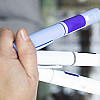Sunscreens: New wave in sun protection: Blocking ultraviolet A
Sunscreens
New wave in sun protection: Blocking ultraviolet A
Many of us are careful to look for a high sun protection factor (SPF) when we buy sunscreens, moisturizers, and makeup. But here's the rub: SPF only measures protection from one type of harmful rays — the so-called ultraviolet B (UVB) rays that cause sunburn. Unfortunately, sunburn protection doesn't equal skin cancer prevention. UVB was once regarded as the main culprit in skin cancer as well as in sunburn, but experts now think that light waves in the ultraviolet A (UVA) part of the spectrum are no less important in contributing to skin cancer. UVA, which penetrates the skin more deeply than UVB, also contributes to skin aging.
You can buy sunscreens that claim to block both UVA and UVB, but there's little FDA regulation of such claims — and still no rating system (like SPF) to measure or compare a sunscreen's effectiveness against UVA. (As of this writing, the FDA has been working on one for several years.) Several ingredients are approved for blocking or absorbing UVA, but most have shortcomings. For example, methyl anthranilate doesn't filter out enough UVA. Avobenzone is a good UVA blocker, but tends to break down in sunlight. Other ingredients can be difficult to incorporate in a lotion or cream.
An ingredient called Mexoryl SX, considered by many experts to offer the best protection against UVA, has not been available in the United States. But in July 2006, the FDA approved Anthelios SX, an over-the-counter sunscreen made by L'Oreal, which contains Mexoryl SX, avobenzone, and octocrylene (a UVA-UVB filter that also helps stabilize avobenzone). Dermatologists are also enthusiastic about a line of Neutrogena sun products — the best known is Ultra Sheer Dry-Touch sunblock — that uses a patented technology dubbed Helioplex to stabilize its UVA and UVB blocking agents, in particular, avobenzone and oxybenzone. The result is a broader-spectrum, longer-lasting sunscreen.
Of course, no sunscreen works unless you apply enough of it: Experts suggest about two tablespoons per application for an average-sized adult. And sunscreens aren't the only way to protect your skin. Many outfitters carry stylish sun-protective clothing, including hats, scarves, shirts, and pants. It's also a good idea to avoid the midday sun.
Disclaimer:
As a service to our readers, Harvard Health Publishing provides access to our library of archived content. Please note the date of last review or update on all articles.
No content on this site, regardless of date, should ever be used as a substitute for direct medical advice from your doctor or other qualified clinician.












